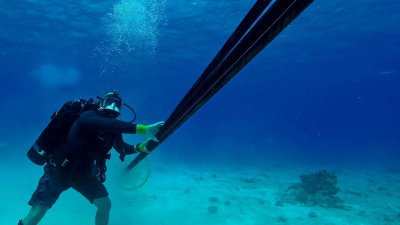The US plans to build a successor to its unique USS Jimmy Carter spy submarine, bringing updated capabilities necessary for seabed warfare operations as tensions mount with China across various maritime theaters.
This month, Naval News reported that the US Navy would procure a one-off spy variant of the Virginia-class nuclear attack submarine, designated Modified Virginia, Subsea and Seabed Warfare (Mod VA SSW).
The source notes that preliminary work by the Electric Boat shipyard in Groton, Connecticut, has begun with one Mod VA SSW to be procured in the US Navy’s 2024 budget at an estimated cost of US$5.1 billion.
While many details of the Mod VA SSW are classified, Naval News reports that the submarine can be expected to carry specialist uncrewed underwater vehicles (UUV), remote-operated vehicles and special operations submarines.
Asia Times has noted some of these assets, including the Orca Extra Large Unmanned Undersea Vehicle (XLUUV) and the MK11 SEAL Delivery Vehicle (SDV).
The Orca XLUUV can be deployed for surveillance and offensive seabed warfare operations such as minelaying, anti-submarine and special operations.
The MK 11 SDV can also stealthily transport SEAL teams to destroy China’s military installations in remote South China Sea islands, infiltrate enemy naval bases and sink hostile warships at port, or deploy SEAL teams in remote islands to perform surveillance or direct long-range precision fire from US and allied naval and air assets.
As with the USS Jimmy Carter, the Mod VA SSW may also be able to cut and tap undersea fiber optic communications cables.
Olga Khazan notes in a 2013 article for The Atlantic that the most accessible points for submarine cable tapping operations are at “regeneration points,” where signals are amplified and pushed further down the line.
Khazan notes that fiber optic cables can be tapped more easily at these spots as they are laid out individually rather than being bundled together.

Khazan writes that “intercept probes” could be deployed by agents at cable landing stations. These tiny devices capture light sent through the cables, copy it and turn it into data without disrupting Internet traffic.
She also mentions that slightly bending the cables can allow enough light to leak out for data extraction, with the resulting disruption so indiscernible that it doesn’t register the cables are being tapped.
Bryan Clark notes in a 2015 report for the Center for Strategic and Budgetary Assessments that the expansion of undersea infrastructure including energy pipelines, undersea communication cables and civilian hydroacoustic sensors has made it imperative to take new forms of encroachment into account when planning for undersea warfare.
Clark writes these could include accidental detection by non-military sensors, protection of vital undersea infrastructure and opportunities to inflict damage on enemy undersea infrastructure during a conflict.
Seabed warfare presents unique operational challenges. In a December article last year, Naval Technology claimed that no country is currently well-equipped or prepared for the challenges of modern seabed warfare.
Naval Technology notes that seabed warfare has an element of plausible deniability, adding a hybrid dimension to offensive seabed warfare operations.
An attack against undersea internet cables can have devastating consequences. Bryan Clark notes in a 2016 article for the Bulletin of Atomic Scientists that the loss of communications caused by severed undersea internet cables can have disastrous consequences for time-sensitive diplomatic or military communications, cause massive financial losses as money transfers are disrupted and cripple other crucial systems as data is re-routed to other cables.
Clark elaborates on the further military consequences of such an attack, noting that an aggressor can sever multiple cables to cut off a defender’s military from its national leadership, intelligence and sensor information.
These attacks can be highly destabilizing at the strategic nuclear level by potentially preventing a nuclear-armed opponent from controlling and monitoring its nuclear weapons and early warning systems, forcing the latter to keep its nuclear arsenal on heightened alert and increasing the chances of a pre-emptive nuclear strike.
Taiwan is at the center of these undersea warfare risks. Last November, Asia Times noted that Taiwan has 15 undersea internet cables connecting it to the outside world from three landing stations on its main island which China could attack in a conflict scenario, cutting the self-governing island’s access to external information.
Apart from Taiwan, the US Navy Fishhook Undersea Defense Line may be an inviting target for Chinese seabed warfare attacks. Asia Times noted this month that a network of hydrophones, sensors and strategically placed assets stretching from northern China running through Taiwan, the Philippines and Indonesia could monitor China’s nuclear ballistic missile submarines (SSBN), particularly if they attempted to break out into the Pacific and put the US mainland in range of their submarine-launched ballistic missiles (SLBM).
Significantly, a Chinese seabed attack against that sensor network may be interpreted by the US as a prelude to a nuclear strike.

China may also be concerned about the vulnerability of its undersea communications cables. South China Morning Post (SCMP) reported in December 2021 that China built two bases to maintain undersea cables in the East and South China Seas, with the construction of the latter base in Hainan starting that year and planned to be operational by 2023.
SCMP also reported in March last year about China’s “Peace Cable” project. The undersea cable stretches for 15,000 kilometers connecting China, Europe and Africa, starting from Gwadar in Pakistan, passing through Kenya, Djibouti and Somalia, and ending in France with its second phase to expand to Singapore and South Africa.
Apart from the US, other major naval powers have developed specialized capabilities for seabed warfare. For example, Asia Times last July reported on Russia’s Belgorod submarine, which is designed to carry the Poseidon nuclear-armed underwater drone and the Losharik special mission submarine.
Russia’s Losharik is an unarmed saboteur submarine reportedly capable of diving down to 6,000 meters and is purportedly Russia’s most silent and least detectable submarine.
It is designed to plant depth charges at inaccessible locations, conduct surveillance, tap underwater communication cables and perform submarine rescue and special operations.

